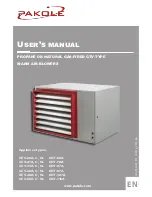
Figure 75
1.
Hydraulic filter
6.
Once the reservoir is filled, start the engine and let it
run at low idle for approximately two minutes. Activate
steering and raise/lower cutting units several times to
purge air from the system. Stop the engine and check
for leaks.
Checking the Hydraulic Lines
and Hoses
Service Interval:
Every 2 years
Inspect the hydraulic lines and hoses daily for leaks, kinked
lines, loose mounting supports, wear, loose fittings, weather
deterioration, and chemical deterioration. Make all necessary
repairs before operating.
WARNING
Hydraulic fluid escaping under pressure can
penetrate skin and cause injury.
•
Make sure all hydraulic fluid hoses and lines are
in good condition and all hydraulic connections
and fittings are tight before applying pressure to
the hydraulic system.
•
Keep your body and hands away from pin
hole leaks or nozzles that eject high pressure
hydraulic fluid.
•
Use cardboard or paper to find hydraulic leaks.
•
Safely relieve all pressure in the hydraulic system
before performing any work on the hydraulic
system.
•
Seek immediate medical attention if fluid is
injected into skin.
Adjusting the Counterbalance
Pressure
The counterbalance test port (Figure 76) is used to test
the pressure in the counterbalance circuit. Recommended
counterbalance pressure is 2241 kPa (325 psi). To adjust
the counterbalance pressure, loosen the locknut, rotate the
adjusting screw (Figure 76) clockwise to increase the pressure
or counterclockwise to decrease the pressure and tighten the
locknut. The engine must be running, the deck lowered and
in float to check pressure.
Note:
The castor wheels of all three cutting units should
remain on the ground when adjusting the counterbalance and
with counterbalance applied.
Figure 76
1.
Counterbalance adjusting
screw
2.
Counterbalance test port
52
Содержание Groundsmaster 4000-D
Страница 60: ...Schematics Hydraulic Schematic Rev B 60 ...
Страница 61: ...Notes 61 ...
Страница 62: ...Notes 62 ...
Страница 63: ...Notes 63 ...













































